Lyresnakes Found in California


| Mildly Venomous but Not Dangerous Lyresnakes have a mild venom that is not dangerous to most humans, but may cause a negative reaction in some. |
||
This nocturnal snake is most often seen crossing roads at night in rocky areas in deserts and mountain slopes in southern California. |
||
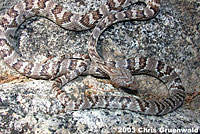 |
 |
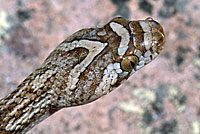 |
| Sonoran Lyresnake - Trimorphodon lambda | ||
 |
 |
 |
| California Lyresnake - Trimorphodon lyrophanes |
||
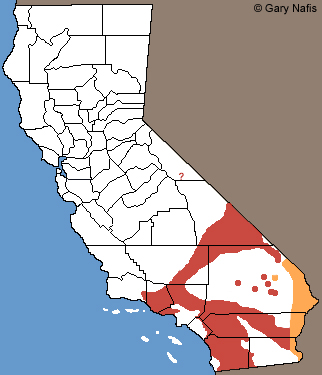 |
||
| Range Map Cyan: Trimorphodon lambda - Sonoran Lyresnake Red: Trimorphodon lyrophanes - California Lyresnake |
||
| Comparison of the Two Species of Lyresnake Found in California | ||
| Where you can't use the range to differentiate the two species, these basic differences might help: Sonoran Lyresnake - Trimorphodon lambda Has fewer body blotches than T. lyrophanes. (Fewer than 31 primary dark body blotches - average of 24.) Body blotches are more widely separated than those on T. lyrophanes. (The seventh and eighth blotches are separated by an average of four scale rows.) The anal scale is divided. California Lyresnake - Trimorphodon lyrophanes Has a greater number of body blotches than T. lambda. (Fewer than 48 primary dark body blotches - (average of 34.) Body blotches are more narrowly separated than those on T. lambda. (The seventh and eighth blotches are separated by an average of two scale rows.) The anal scale is divided or undivided (entire.) |
||
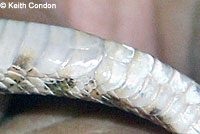 |
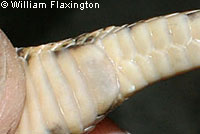 |
|
| Example of the divided anal plate of T. lambda © Keith Condon |
Example of the undivided anal plate of T. lyrophanes. © William Flaxington |
|
| Descriptions of the two species and their distribution taken from this publication: Thomas J. Devitt, Travis J. LaDuc, and Jimmy A. McGuire (2008) The Trimorphodon biscutatus (Squamata: Colubridae) Species Complex Revisited: A Multivariate Statistical Analysis of Geographic Variation. Copeia: June 2008, Vol. 2008, No. 2, pp. 370-387. |
||
| California Lyresnake - Trimorphodon lyrophanes |
||
| “A species of Trimorphodon defined by the following combination of characteristics: primary dark body blotches fewer than 48 (mean of 34), 2–7 scales wide along middorsal line at midbody (mean of five), central pale spots divide primary blotches, resulting secondary blotches undivided; seventh and eighth blotches separated by two scale rows on average; ventrals 214–237 in males, 221–250 in females; midbody scale rows 19–24 (mean of 22); lyre-shaped marking on top of head often incomplete at the apex (resembling a lyre), with a dark bar between the eyes or across snout; anal divided or entire; size small (maximum observed SVL of males 5 774 mm, females 5 936 mm).” “Diagnosis.—This species is distinguished … from T. lambda … by having a greater number of body blotches (mean of 34 in T. lyrophanes, 24 in T. lambda…) that are more narrowly separated (seventh and eighth blotches separated by two scale rows on average in T. lyrophanes, four in T. lambda…)” “Distribution.—Found throughout most of the Baja California Peninsula and on Cerralvo, Danzante, San Jose´, San Marcos, and Tiburo´n islands; in southern California generally west of the Salton Trough region north to the vicinity of Los Angeles on the coast, and inland in the Mohave Desert north to the Argus and Amargosa mountains in Inyo County.” |
||
| Sonoran Lyresnake - Trimorphodon lambda | ||
| “A species of Trimorphodon defined by the following combination of characteristics: primary dark body blotches fewer than 31 (mean of 24), 3–9 scales wide along middorsal line at midbody (mean of five), central pale spots dividing primary blotches, resulting secondary blotches undivided; seventh and eighth blotches separated by four scale rows on average; ventrals 211–240 in males, 223–249 in females; midbody scale rows 19–25 (mean of 22); usually with a complete lyre-shaped marking on top of head and a dark bar between the eyes or across snout, but head markings may be reduced, especially in specimens from extreme southeastern Arizona (Cochise Co.) and southwestern New Mexico (Grant and Hidalgo counties); anal divided; size small (maximum observed SVL of males 5 885 mm, females 5 890 mm).” “Diagnosis.—This species is distinguished … from T. lyrophanes by having fewer body blotches (mean of 24 in T. lambda, 34 in T. lyrophanes) that are more widely separated (seventh and eighth blotches separated by four scale rows on average in T. lambda, two in T. lyrophanes)….” “Distribution.—Found from southern Nevada (Nye Co.), extreme southwestern Utah (Washington Co.), south through much of Arizona except for the northeastern quarter, southwestern New Mexico (Hidalgo and Grant counties), southeastern California generally east of the Salton Trough region, south through Sonora and western Chihuahua west of the Sierra Madre Occidental, to northern Sinaloa.” |
||
Return to the Top
© 2000 -
